Corporate Accounting Assignment - Fair Value and Impairment
VerifiedAdded on 2023/01/05
|13
|2757
|96
Report
AI Summary
This report delves into the intricacies of corporate accounting, focusing on fair value measurement and impairment loss. Part 1 provides an in-depth explanation of fair value accounting, detailing its principles, the role of IFRS 13, valuation techniques (market, income, and cost approaches), and disclosure requirements. The report emphasizes the importance of market participant assumptions and the fair value hierarchy. Part 2 applies these concepts to a case study involving Gali Ltd, a Cash Generating Unit (CGU). It includes detailed calculations for impairment loss, allocation of the loss across assets (Goodwill, Patent, Equipment, Building), and presents the corresponding journal entries. The report adheres to accounting standards and provides clear explanations of the methods used to determine values, such as the recoverable amount and carrying amount of assets. The analysis includes the impact of impairment on asset values and the allocation of losses based on asset carrying amounts. This report is a comprehensive guide to understanding and applying fair value and impairment accounting principles.
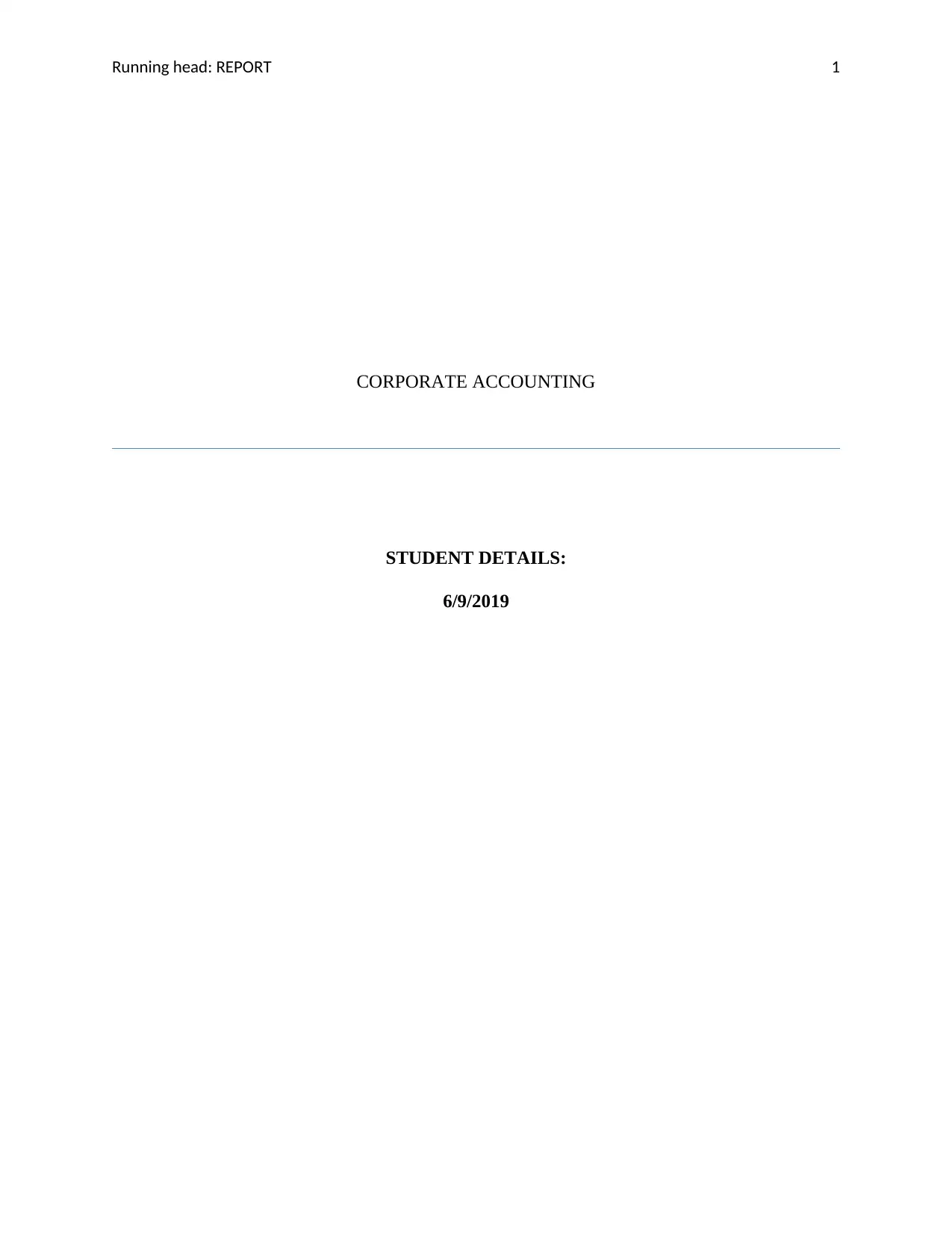
Running head: REPORT 1
CORPORATE ACCOUNTING
STUDENT DETAILS:
6/9/2019
CORPORATE ACCOUNTING
STUDENT DETAILS:
6/9/2019
Secure Best Marks with AI Grader
Need help grading? Try our AI Grader for instant feedback on your assignments.
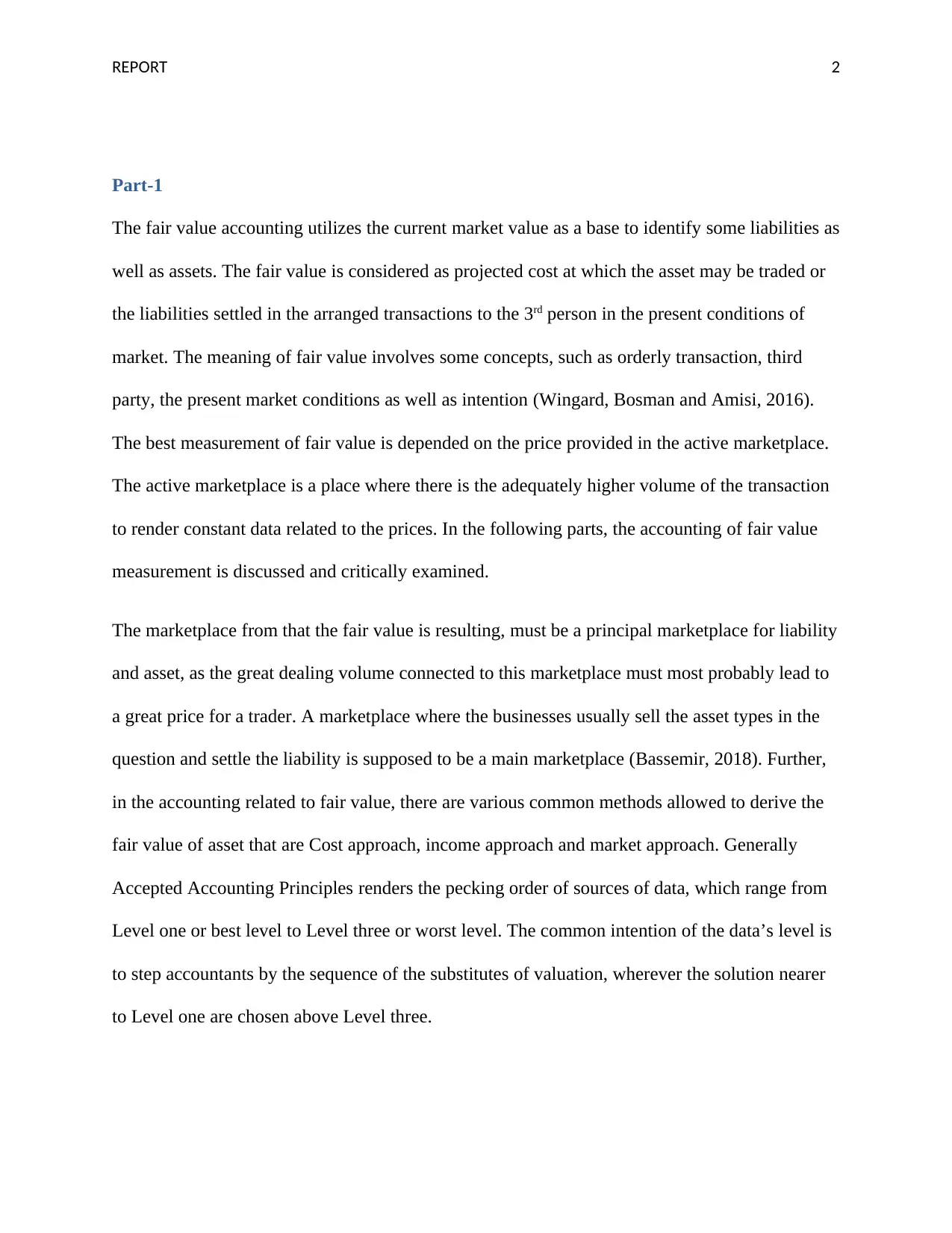
REPORT 2
Part-1
The fair value accounting utilizes the current market value as a base to identify some liabilities as
well as assets. The fair value is considered as projected cost at which the asset may be traded or
the liabilities settled in the arranged transactions to the 3rd person in the present conditions of
market. The meaning of fair value involves some concepts, such as orderly transaction, third
party, the present market conditions as well as intention (Wingard, Bosman and Amisi, 2016).
The best measurement of fair value is depended on the price provided in the active marketplace.
The active marketplace is a place where there is the adequately higher volume of the transaction
to render constant data related to the prices. In the following parts, the accounting of fair value
measurement is discussed and critically examined.
The marketplace from that the fair value is resulting, must be a principal marketplace for liability
and asset, as the great dealing volume connected to this marketplace must most probably lead to
a great price for a trader. A marketplace where the businesses usually sell the asset types in the
question and settle the liability is supposed to be a main marketplace (Bassemir, 2018). Further,
in the accounting related to fair value, there are various common methods allowed to derive the
fair value of asset that are Cost approach, income approach and market approach. Generally
Accepted Accounting Principles renders the pecking order of sources of data, which range from
Level one or best level to Level three or worst level. The common intention of the data’s level is
to step accountants by the sequence of the substitutes of valuation, wherever the solution nearer
to Level one are chosen above Level three.
Part-1
The fair value accounting utilizes the current market value as a base to identify some liabilities as
well as assets. The fair value is considered as projected cost at which the asset may be traded or
the liabilities settled in the arranged transactions to the 3rd person in the present conditions of
market. The meaning of fair value involves some concepts, such as orderly transaction, third
party, the present market conditions as well as intention (Wingard, Bosman and Amisi, 2016).
The best measurement of fair value is depended on the price provided in the active marketplace.
The active marketplace is a place where there is the adequately higher volume of the transaction
to render constant data related to the prices. In the following parts, the accounting of fair value
measurement is discussed and critically examined.
The marketplace from that the fair value is resulting, must be a principal marketplace for liability
and asset, as the great dealing volume connected to this marketplace must most probably lead to
a great price for a trader. A marketplace where the businesses usually sell the asset types in the
question and settle the liability is supposed to be a main marketplace (Bassemir, 2018). Further,
in the accounting related to fair value, there are various common methods allowed to derive the
fair value of asset that are Cost approach, income approach and market approach. Generally
Accepted Accounting Principles renders the pecking order of sources of data, which range from
Level one or best level to Level three or worst level. The common intention of the data’s level is
to step accountants by the sequence of the substitutes of valuation, wherever the solution nearer
to Level one are chosen above Level three.
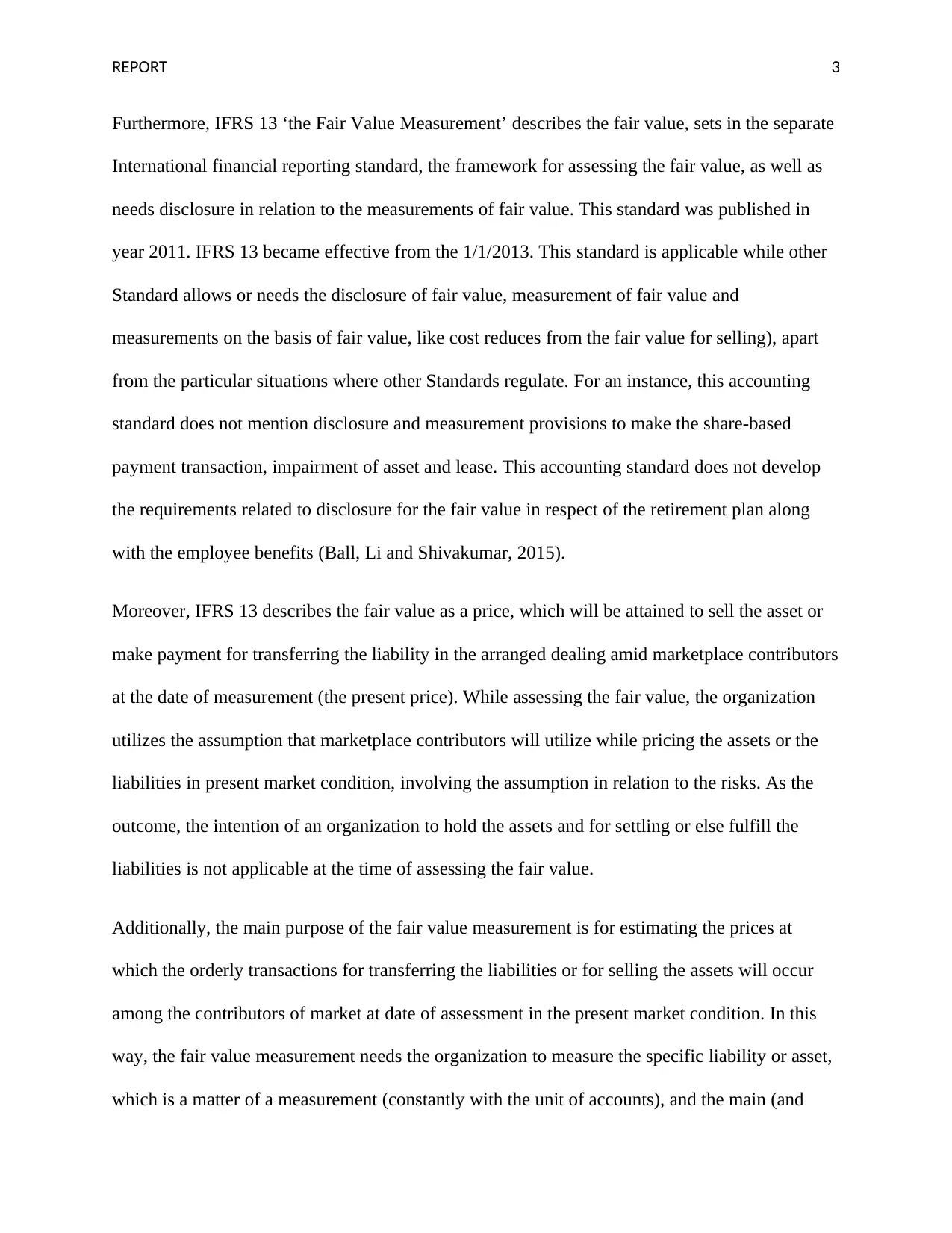
REPORT 3
Furthermore, IFRS 13 ‘the Fair Value Measurement’ describes the fair value, sets in the separate
International financial reporting standard, the framework for assessing the fair value, as well as
needs disclosure in relation to the measurements of fair value. This standard was published in
year 2011. IFRS 13 became effective from the 1/1/2013. This standard is applicable while other
Standard allows or needs the disclosure of fair value, measurement of fair value and
measurements on the basis of fair value, like cost reduces from the fair value for selling), apart
from the particular situations where other Standards regulate. For an instance, this accounting
standard does not mention disclosure and measurement provisions to make the share-based
payment transaction, impairment of asset and lease. This accounting standard does not develop
the requirements related to disclosure for the fair value in respect of the retirement plan along
with the employee benefits (Ball, Li and Shivakumar, 2015).
Moreover, IFRS 13 describes the fair value as a price, which will be attained to sell the asset or
make payment for transferring the liability in the arranged dealing amid marketplace contributors
at the date of measurement (the present price). While assessing the fair value, the organization
utilizes the assumption that marketplace contributors will utilize while pricing the assets or the
liabilities in present market condition, involving the assumption in relation to the risks. As the
outcome, the intention of an organization to hold the assets and for settling or else fulfill the
liabilities is not applicable at the time of assessing the fair value.
Additionally, the main purpose of the fair value measurement is for estimating the prices at
which the orderly transactions for transferring the liabilities or for selling the assets will occur
among the contributors of market at date of assessment in the present market condition. In this
way, the fair value measurement needs the organization to measure the specific liability or asset,
which is a matter of a measurement (constantly with the unit of accounts), and the main (and
Furthermore, IFRS 13 ‘the Fair Value Measurement’ describes the fair value, sets in the separate
International financial reporting standard, the framework for assessing the fair value, as well as
needs disclosure in relation to the measurements of fair value. This standard was published in
year 2011. IFRS 13 became effective from the 1/1/2013. This standard is applicable while other
Standard allows or needs the disclosure of fair value, measurement of fair value and
measurements on the basis of fair value, like cost reduces from the fair value for selling), apart
from the particular situations where other Standards regulate. For an instance, this accounting
standard does not mention disclosure and measurement provisions to make the share-based
payment transaction, impairment of asset and lease. This accounting standard does not develop
the requirements related to disclosure for the fair value in respect of the retirement plan along
with the employee benefits (Ball, Li and Shivakumar, 2015).
Moreover, IFRS 13 describes the fair value as a price, which will be attained to sell the asset or
make payment for transferring the liability in the arranged dealing amid marketplace contributors
at the date of measurement (the present price). While assessing the fair value, the organization
utilizes the assumption that marketplace contributors will utilize while pricing the assets or the
liabilities in present market condition, involving the assumption in relation to the risks. As the
outcome, the intention of an organization to hold the assets and for settling or else fulfill the
liabilities is not applicable at the time of assessing the fair value.
Additionally, the main purpose of the fair value measurement is for estimating the prices at
which the orderly transactions for transferring the liabilities or for selling the assets will occur
among the contributors of market at date of assessment in the present market condition. In this
way, the fair value measurement needs the organization to measure the specific liability or asset,
which is a matter of a measurement (constantly with the unit of accounts), and the main (and
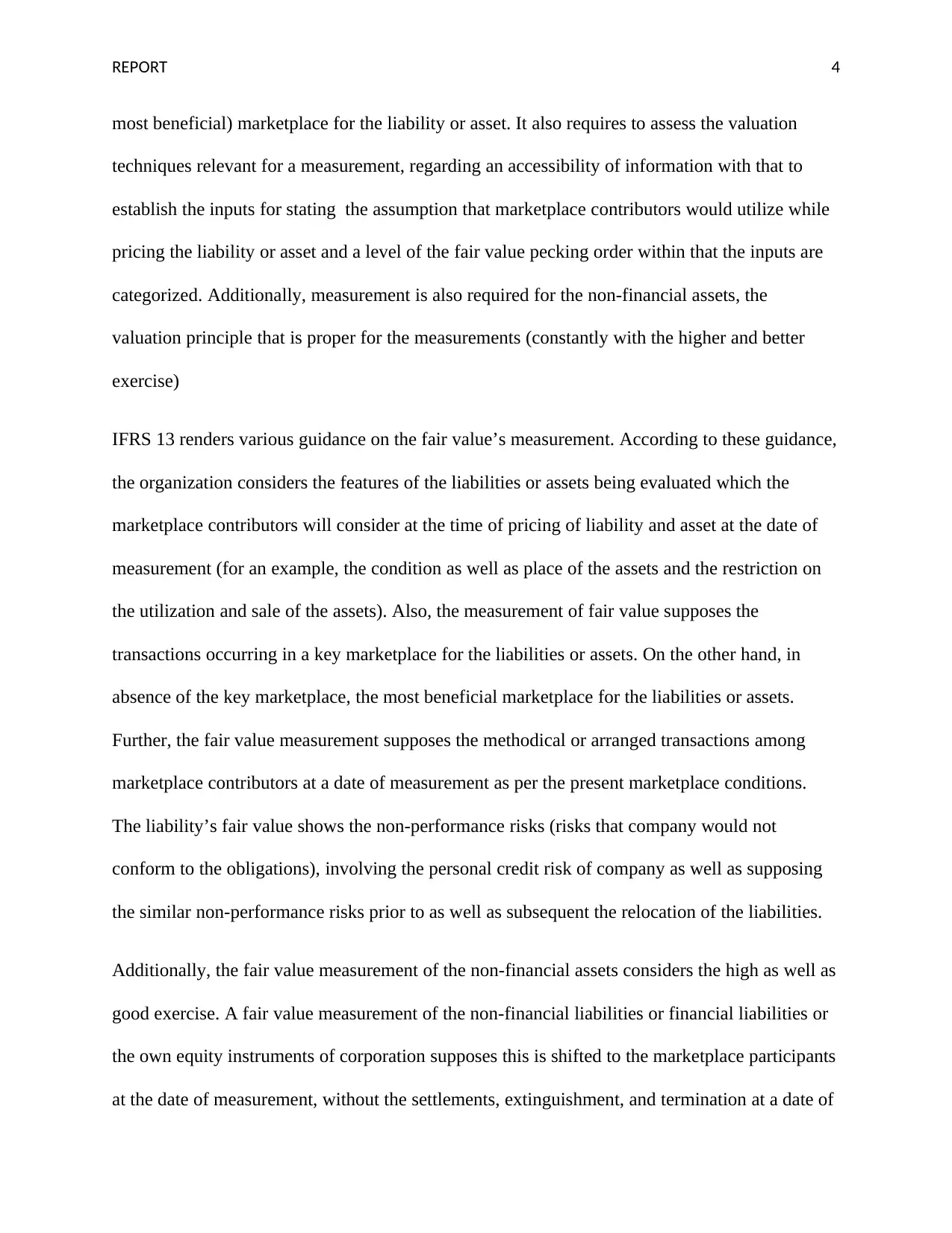
REPORT 4
most beneficial) marketplace for the liability or asset. It also requires to assess the valuation
techniques relevant for a measurement, regarding an accessibility of information with that to
establish the inputs for stating the assumption that marketplace contributors would utilize while
pricing the liability or asset and a level of the fair value pecking order within that the inputs are
categorized. Additionally, measurement is also required for the non-financial assets, the
valuation principle that is proper for the measurements (constantly with the higher and better
exercise)
IFRS 13 renders various guidance on the fair value’s measurement. According to these guidance,
the organization considers the features of the liabilities or assets being evaluated which the
marketplace contributors will consider at the time of pricing of liability and asset at the date of
measurement (for an example, the condition as well as place of the assets and the restriction on
the utilization and sale of the assets). Also, the measurement of fair value supposes the
transactions occurring in a key marketplace for the liabilities or assets. On the other hand, in
absence of the key marketplace, the most beneficial marketplace for the liabilities or assets.
Further, the fair value measurement supposes the methodical or arranged transactions among
marketplace contributors at a date of measurement as per the present marketplace conditions.
The liability’s fair value shows the non-performance risks (risks that company would not
conform to the obligations), involving the personal credit risk of company as well as supposing
the similar non-performance risks prior to as well as subsequent the relocation of the liabilities.
Additionally, the fair value measurement of the non-financial assets considers the high as well as
good exercise. A fair value measurement of the non-financial liabilities or financial liabilities or
the own equity instruments of corporation supposes this is shifted to the marketplace participants
at the date of measurement, without the settlements, extinguishment, and termination at a date of
most beneficial) marketplace for the liability or asset. It also requires to assess the valuation
techniques relevant for a measurement, regarding an accessibility of information with that to
establish the inputs for stating the assumption that marketplace contributors would utilize while
pricing the liability or asset and a level of the fair value pecking order within that the inputs are
categorized. Additionally, measurement is also required for the non-financial assets, the
valuation principle that is proper for the measurements (constantly with the higher and better
exercise)
IFRS 13 renders various guidance on the fair value’s measurement. According to these guidance,
the organization considers the features of the liabilities or assets being evaluated which the
marketplace contributors will consider at the time of pricing of liability and asset at the date of
measurement (for an example, the condition as well as place of the assets and the restriction on
the utilization and sale of the assets). Also, the measurement of fair value supposes the
transactions occurring in a key marketplace for the liabilities or assets. On the other hand, in
absence of the key marketplace, the most beneficial marketplace for the liabilities or assets.
Further, the fair value measurement supposes the methodical or arranged transactions among
marketplace contributors at a date of measurement as per the present marketplace conditions.
The liability’s fair value shows the non-performance risks (risks that company would not
conform to the obligations), involving the personal credit risk of company as well as supposing
the similar non-performance risks prior to as well as subsequent the relocation of the liabilities.
Additionally, the fair value measurement of the non-financial assets considers the high as well as
good exercise. A fair value measurement of the non-financial liabilities or financial liabilities or
the own equity instruments of corporation supposes this is shifted to the marketplace participants
at the date of measurement, without the settlements, extinguishment, and termination at a date of
Secure Best Marks with AI Grader
Need help grading? Try our AI Grader for instant feedback on your assignments.
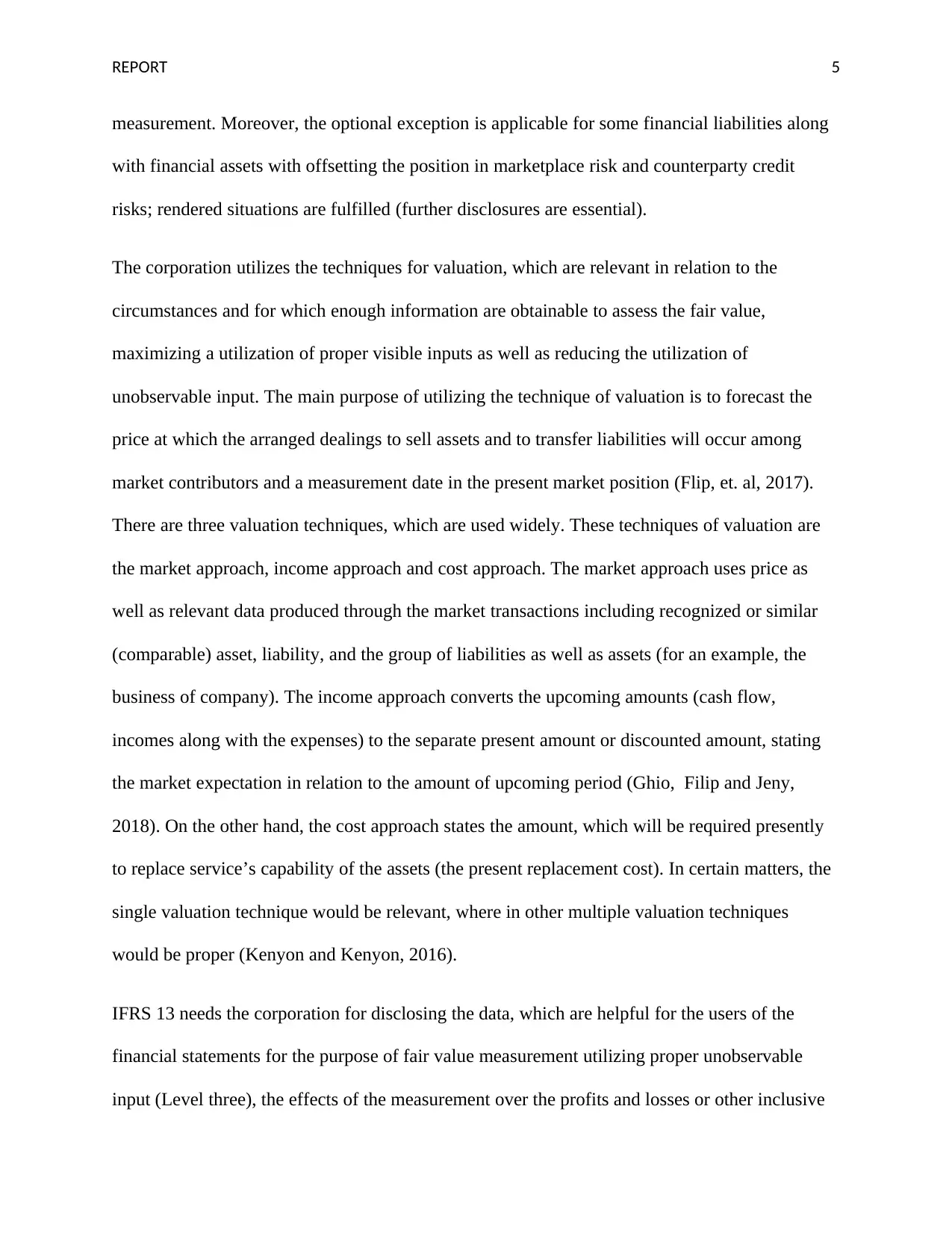
REPORT 5
measurement. Moreover, the optional exception is applicable for some financial liabilities along
with financial assets with offsetting the position in marketplace risk and counterparty credit
risks; rendered situations are fulfilled (further disclosures are essential).
The corporation utilizes the techniques for valuation, which are relevant in relation to the
circumstances and for which enough information are obtainable to assess the fair value,
maximizing a utilization of proper visible inputs as well as reducing the utilization of
unobservable input. The main purpose of utilizing the technique of valuation is to forecast the
price at which the arranged dealings to sell assets and to transfer liabilities will occur among
market contributors and a measurement date in the present market position (Flip, et. al, 2017).
There are three valuation techniques, which are used widely. These techniques of valuation are
the market approach, income approach and cost approach. The market approach uses price as
well as relevant data produced through the market transactions including recognized or similar
(comparable) asset, liability, and the group of liabilities as well as assets (for an example, the
business of company). The income approach converts the upcoming amounts (cash flow,
incomes along with the expenses) to the separate present amount or discounted amount, stating
the market expectation in relation to the amount of upcoming period (Ghio, Filip and Jeny,
2018). On the other hand, the cost approach states the amount, which will be required presently
to replace service’s capability of the assets (the present replacement cost). In certain matters, the
single valuation technique would be relevant, where in other multiple valuation techniques
would be proper (Kenyon and Kenyon, 2016).
IFRS 13 needs the corporation for disclosing the data, which are helpful for the users of the
financial statements for the purpose of fair value measurement utilizing proper unobservable
input (Level three), the effects of the measurement over the profits and losses or other inclusive
measurement. Moreover, the optional exception is applicable for some financial liabilities along
with financial assets with offsetting the position in marketplace risk and counterparty credit
risks; rendered situations are fulfilled (further disclosures are essential).
The corporation utilizes the techniques for valuation, which are relevant in relation to the
circumstances and for which enough information are obtainable to assess the fair value,
maximizing a utilization of proper visible inputs as well as reducing the utilization of
unobservable input. The main purpose of utilizing the technique of valuation is to forecast the
price at which the arranged dealings to sell assets and to transfer liabilities will occur among
market contributors and a measurement date in the present market position (Flip, et. al, 2017).
There are three valuation techniques, which are used widely. These techniques of valuation are
the market approach, income approach and cost approach. The market approach uses price as
well as relevant data produced through the market transactions including recognized or similar
(comparable) asset, liability, and the group of liabilities as well as assets (for an example, the
business of company). The income approach converts the upcoming amounts (cash flow,
incomes along with the expenses) to the separate present amount or discounted amount, stating
the market expectation in relation to the amount of upcoming period (Ghio, Filip and Jeny,
2018). On the other hand, the cost approach states the amount, which will be required presently
to replace service’s capability of the assets (the present replacement cost). In certain matters, the
single valuation technique would be relevant, where in other multiple valuation techniques
would be proper (Kenyon and Kenyon, 2016).
IFRS 13 needs the corporation for disclosing the data, which are helpful for the users of the
financial statements for the purpose of fair value measurement utilizing proper unobservable
input (Level three), the effects of the measurement over the profits and losses or other inclusive
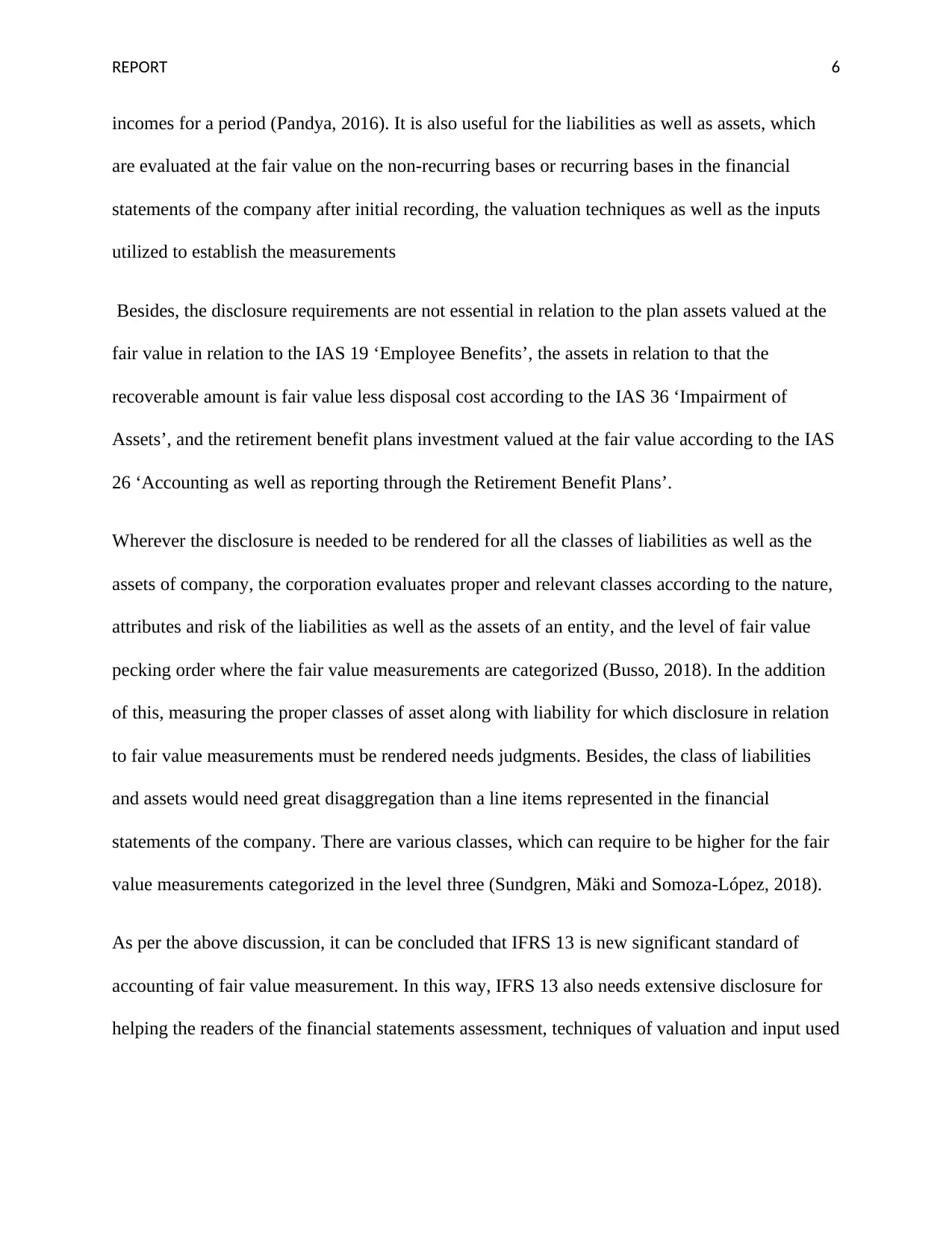
REPORT 6
incomes for a period (Pandya, 2016). It is also useful for the liabilities as well as assets, which
are evaluated at the fair value on the non-recurring bases or recurring bases in the financial
statements of the company after initial recording, the valuation techniques as well as the inputs
utilized to establish the measurements
Besides, the disclosure requirements are not essential in relation to the plan assets valued at the
fair value in relation to the IAS 19 ‘Employee Benefits’, the assets in relation to that the
recoverable amount is fair value less disposal cost according to the IAS 36 ‘Impairment of
Assets’, and the retirement benefit plans investment valued at the fair value according to the IAS
26 ‘Accounting as well as reporting through the Retirement Benefit Plans’.
Wherever the disclosure is needed to be rendered for all the classes of liabilities as well as the
assets of company, the corporation evaluates proper and relevant classes according to the nature,
attributes and risk of the liabilities as well as the assets of an entity, and the level of fair value
pecking order where the fair value measurements are categorized (Busso, 2018). In the addition
of this, measuring the proper classes of asset along with liability for which disclosure in relation
to fair value measurements must be rendered needs judgments. Besides, the class of liabilities
and assets would need great disaggregation than a line items represented in the financial
statements of the company. There are various classes, which can require to be higher for the fair
value measurements categorized in the level three (Sundgren, Mäki and Somoza-López, 2018).
As per the above discussion, it can be concluded that IFRS 13 is new significant standard of
accounting of fair value measurement. In this way, IFRS 13 also needs extensive disclosure for
helping the readers of the financial statements assessment, techniques of valuation and input used
incomes for a period (Pandya, 2016). It is also useful for the liabilities as well as assets, which
are evaluated at the fair value on the non-recurring bases or recurring bases in the financial
statements of the company after initial recording, the valuation techniques as well as the inputs
utilized to establish the measurements
Besides, the disclosure requirements are not essential in relation to the plan assets valued at the
fair value in relation to the IAS 19 ‘Employee Benefits’, the assets in relation to that the
recoverable amount is fair value less disposal cost according to the IAS 36 ‘Impairment of
Assets’, and the retirement benefit plans investment valued at the fair value according to the IAS
26 ‘Accounting as well as reporting through the Retirement Benefit Plans’.
Wherever the disclosure is needed to be rendered for all the classes of liabilities as well as the
assets of company, the corporation evaluates proper and relevant classes according to the nature,
attributes and risk of the liabilities as well as the assets of an entity, and the level of fair value
pecking order where the fair value measurements are categorized (Busso, 2018). In the addition
of this, measuring the proper classes of asset along with liability for which disclosure in relation
to fair value measurements must be rendered needs judgments. Besides, the class of liabilities
and assets would need great disaggregation than a line items represented in the financial
statements of the company. There are various classes, which can require to be higher for the fair
value measurements categorized in the level three (Sundgren, Mäki and Somoza-López, 2018).
As per the above discussion, it can be concluded that IFRS 13 is new significant standard of
accounting of fair value measurement. In this way, IFRS 13 also needs extensive disclosure for
helping the readers of the financial statements assessment, techniques of valuation and input used
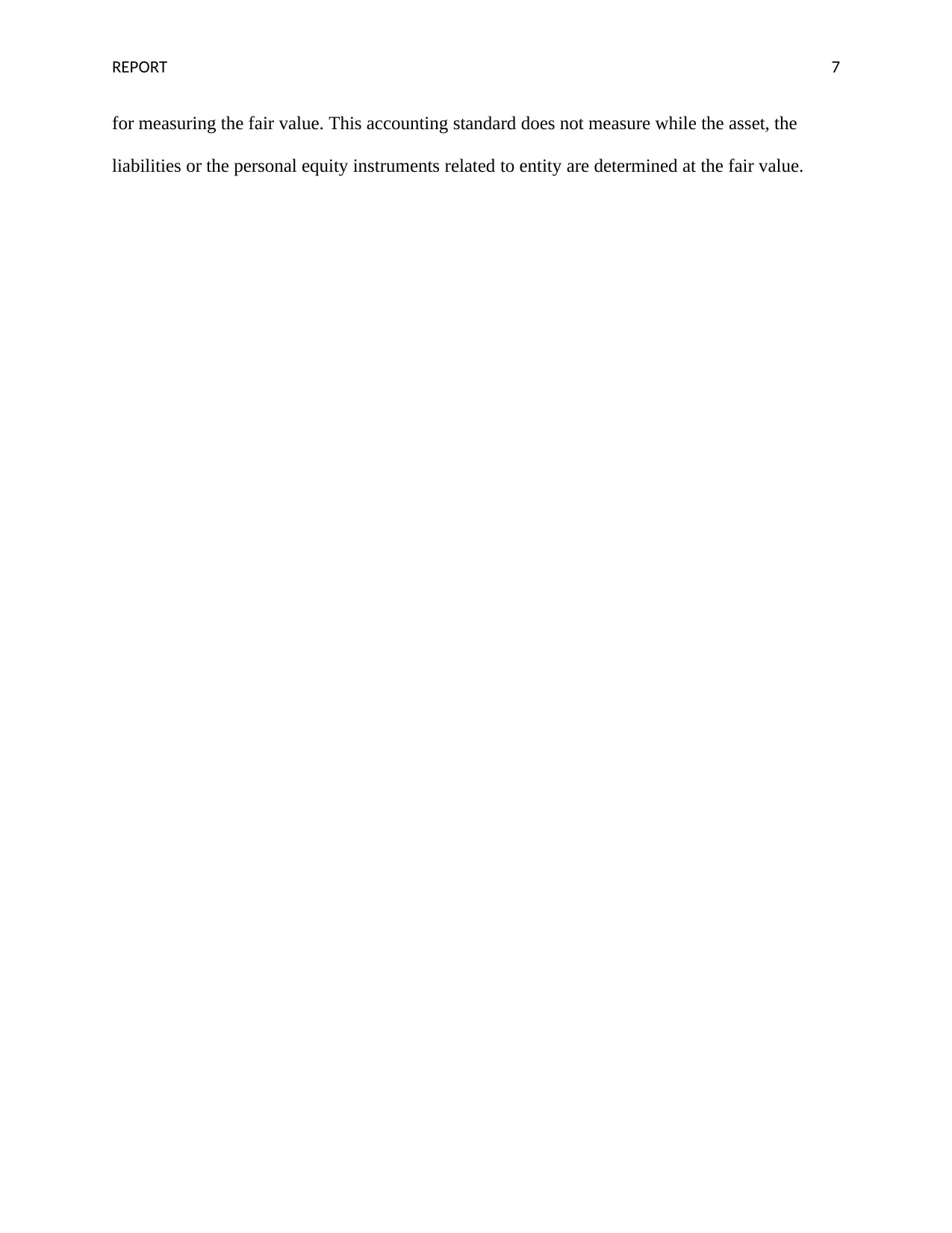
REPORT 7
for measuring the fair value. This accounting standard does not measure while the asset, the
liabilities or the personal equity instruments related to entity are determined at the fair value.
for measuring the fair value. This accounting standard does not measure while the asset, the
liabilities or the personal equity instruments related to entity are determined at the fair value.
Paraphrase This Document
Need a fresh take? Get an instant paraphrase of this document with our AI Paraphraser
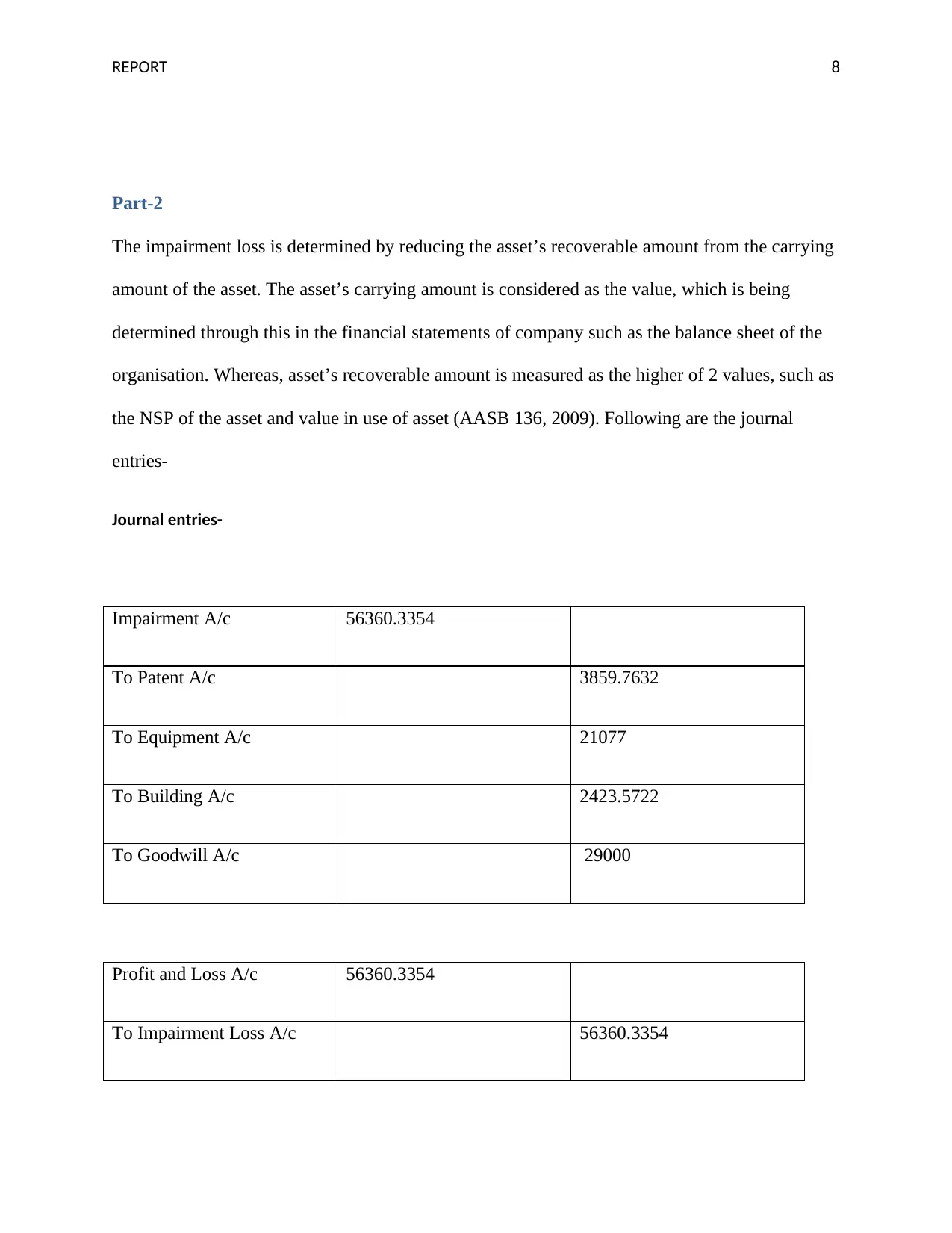
REPORT 8
Part-2
The impairment loss is determined by reducing the asset’s recoverable amount from the carrying
amount of the asset. The asset’s carrying amount is considered as the value, which is being
determined through this in the financial statements of company such as the balance sheet of the
organisation. Whereas, asset’s recoverable amount is measured as the higher of 2 values, such as
the NSP of the asset and value in use of asset (AASB 136, 2009). Following are the journal
entries-
Journal entries-
Impairment A/c 56360.3354
To Patent A/c 3859.7632
To Equipment A/c 21077
To Building A/c 2423.5722
To Goodwill A/c 29000
Profit and Loss A/c 56360.3354
To Impairment Loss A/c 56360.3354
Part-2
The impairment loss is determined by reducing the asset’s recoverable amount from the carrying
amount of the asset. The asset’s carrying amount is considered as the value, which is being
determined through this in the financial statements of company such as the balance sheet of the
organisation. Whereas, asset’s recoverable amount is measured as the higher of 2 values, such as
the NSP of the asset and value in use of asset (AASB 136, 2009). Following are the journal
entries-
Journal entries-
Impairment A/c 56360.3354
To Patent A/c 3859.7632
To Equipment A/c 21077
To Building A/c 2423.5722
To Goodwill A/c 29000
Profit and Loss A/c 56360.3354
To Impairment Loss A/c 56360.3354
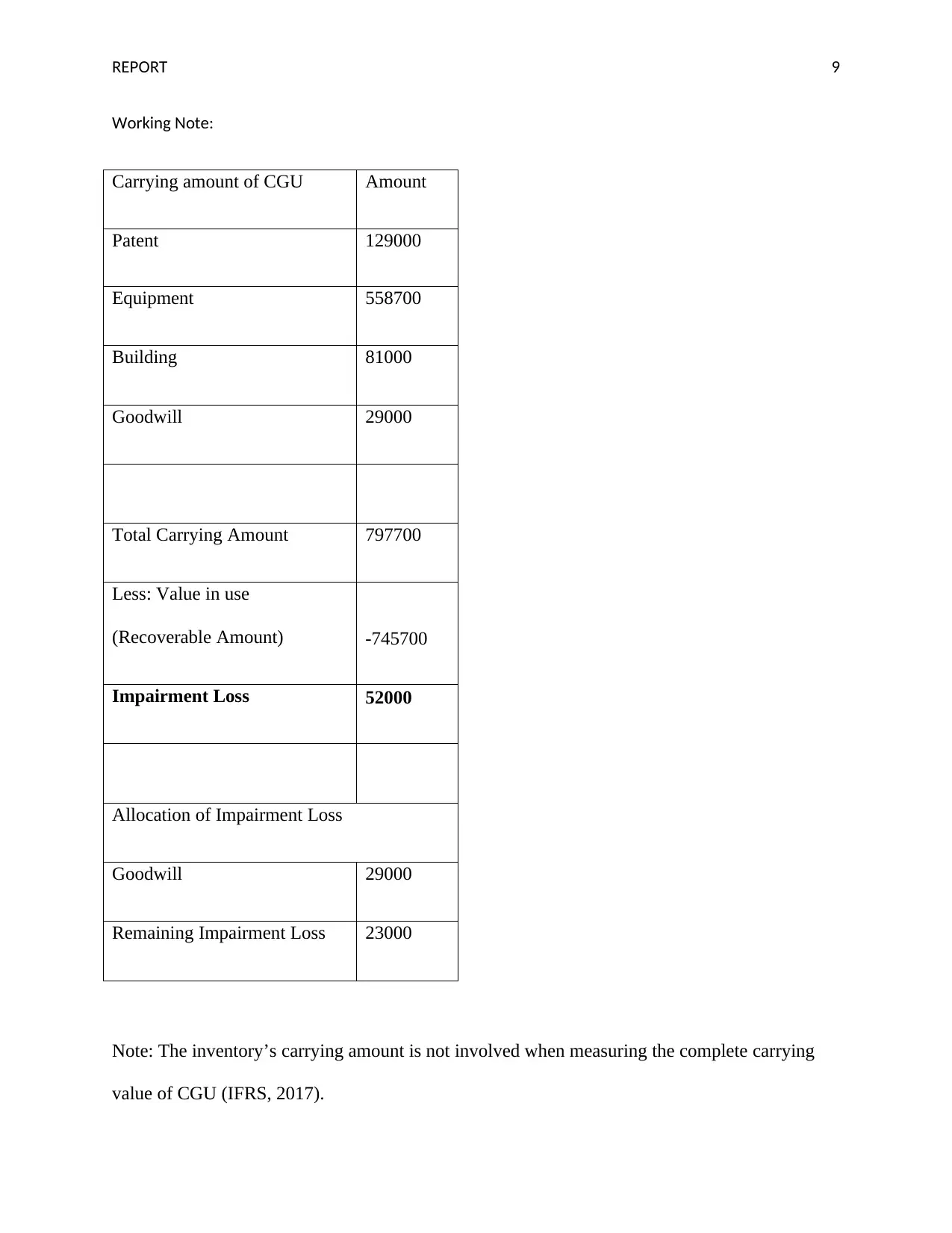
REPORT 9
Working Note:
Carrying amount of CGU Amount
Patent 129000
Equipment 558700
Building 81000
Goodwill 29000
Total Carrying Amount 797700
Less: Value in use
(Recoverable Amount) -745700
Impairment Loss 52000
Allocation of Impairment Loss
Goodwill 29000
Remaining Impairment Loss 23000
Note: The inventory’s carrying amount is not involved when measuring the complete carrying
value of CGU (IFRS, 2017).
Working Note:
Carrying amount of CGU Amount
Patent 129000
Equipment 558700
Building 81000
Goodwill 29000
Total Carrying Amount 797700
Less: Value in use
(Recoverable Amount) -745700
Impairment Loss 52000
Allocation of Impairment Loss
Goodwill 29000
Remaining Impairment Loss 23000
Note: The inventory’s carrying amount is not involved when measuring the complete carrying
value of CGU (IFRS, 2017).
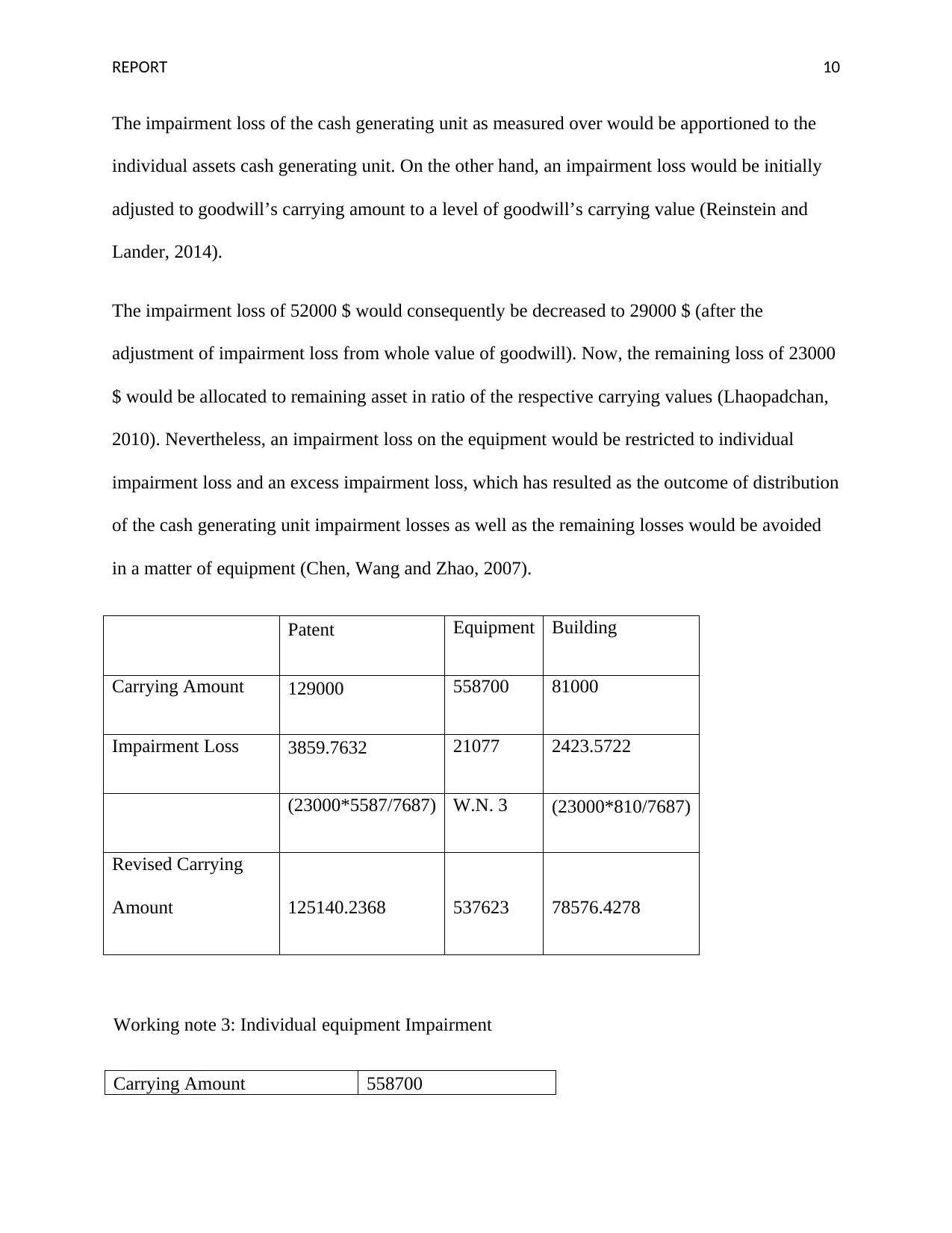
REPORT 10
The impairment loss of the cash generating unit as measured over would be apportioned to the
individual assets cash generating unit. On the other hand, an impairment loss would be initially
adjusted to goodwill’s carrying amount to a level of goodwill’s carrying value (Reinstein and
Lander, 2014).
The impairment loss of 52000 $ would consequently be decreased to 29000 $ (after the
adjustment of impairment loss from whole value of goodwill). Now, the remaining loss of 23000
$ would be allocated to remaining asset in ratio of the respective carrying values (Lhaopadchan,
2010). Nevertheless, an impairment loss on the equipment would be restricted to individual
impairment loss and an excess impairment loss, which has resulted as the outcome of distribution
of the cash generating unit impairment losses as well as the remaining losses would be avoided
in a matter of equipment (Chen, Wang and Zhao, 2007).
Patent Equipment Building
Carrying Amount 129000 558700 81000
Impairment Loss 3859.7632 21077 2423.5722
(23000*5587/7687) W.N. 3 (23000*810/7687)
Revised Carrying
Amount 125140.2368 537623 78576.4278
Working note 3: Individual equipment Impairment
Carrying Amount 558700
The impairment loss of the cash generating unit as measured over would be apportioned to the
individual assets cash generating unit. On the other hand, an impairment loss would be initially
adjusted to goodwill’s carrying amount to a level of goodwill’s carrying value (Reinstein and
Lander, 2014).
The impairment loss of 52000 $ would consequently be decreased to 29000 $ (after the
adjustment of impairment loss from whole value of goodwill). Now, the remaining loss of 23000
$ would be allocated to remaining asset in ratio of the respective carrying values (Lhaopadchan,
2010). Nevertheless, an impairment loss on the equipment would be restricted to individual
impairment loss and an excess impairment loss, which has resulted as the outcome of distribution
of the cash generating unit impairment losses as well as the remaining losses would be avoided
in a matter of equipment (Chen, Wang and Zhao, 2007).
Patent Equipment Building
Carrying Amount 129000 558700 81000
Impairment Loss 3859.7632 21077 2423.5722
(23000*5587/7687) W.N. 3 (23000*810/7687)
Revised Carrying
Amount 125140.2368 537623 78576.4278
Working note 3: Individual equipment Impairment
Carrying Amount 558700
Secure Best Marks with AI Grader
Need help grading? Try our AI Grader for instant feedback on your assignments.
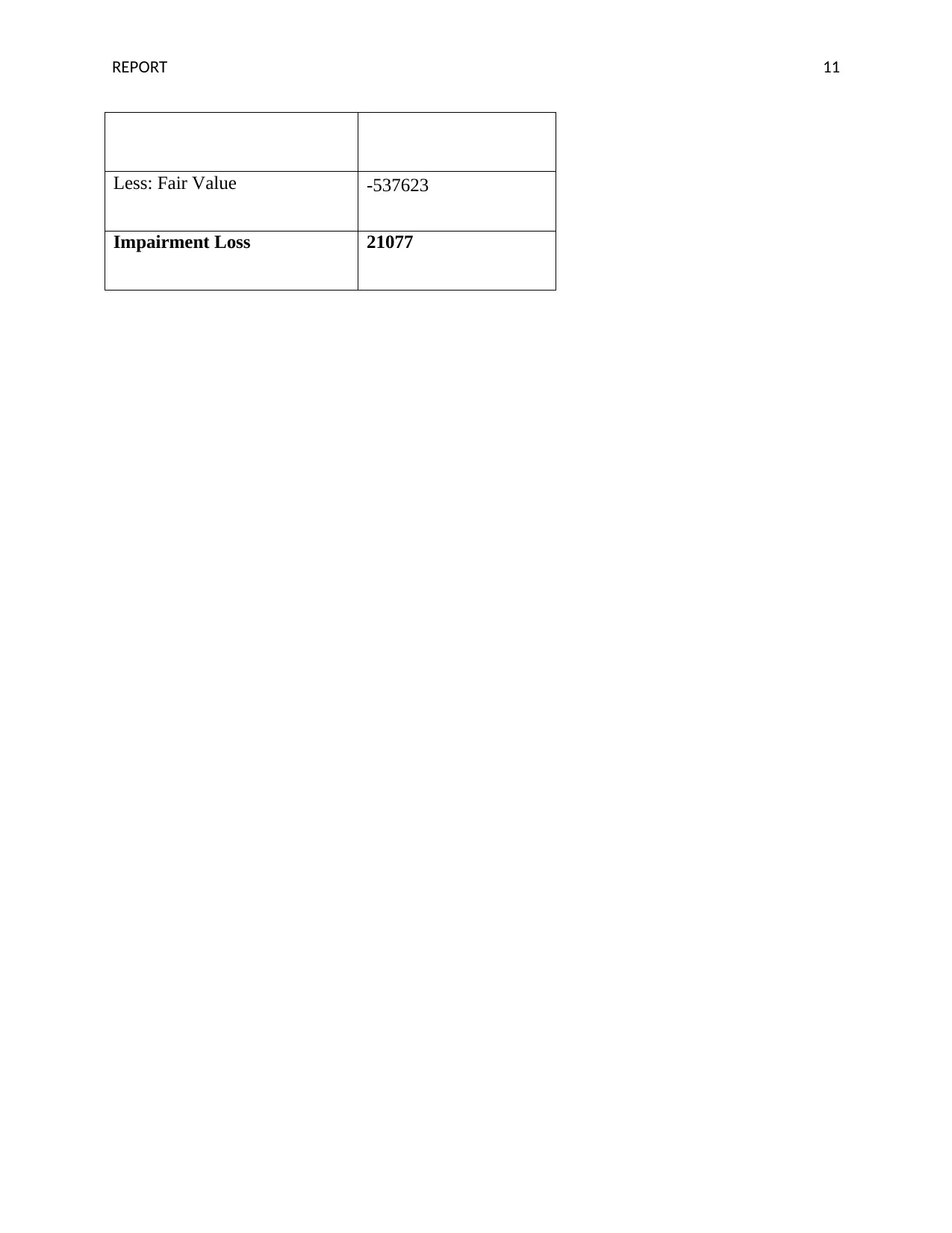
REPORT 11
Less: Fair Value -537623
Impairment Loss 21077
Less: Fair Value -537623
Impairment Loss 21077
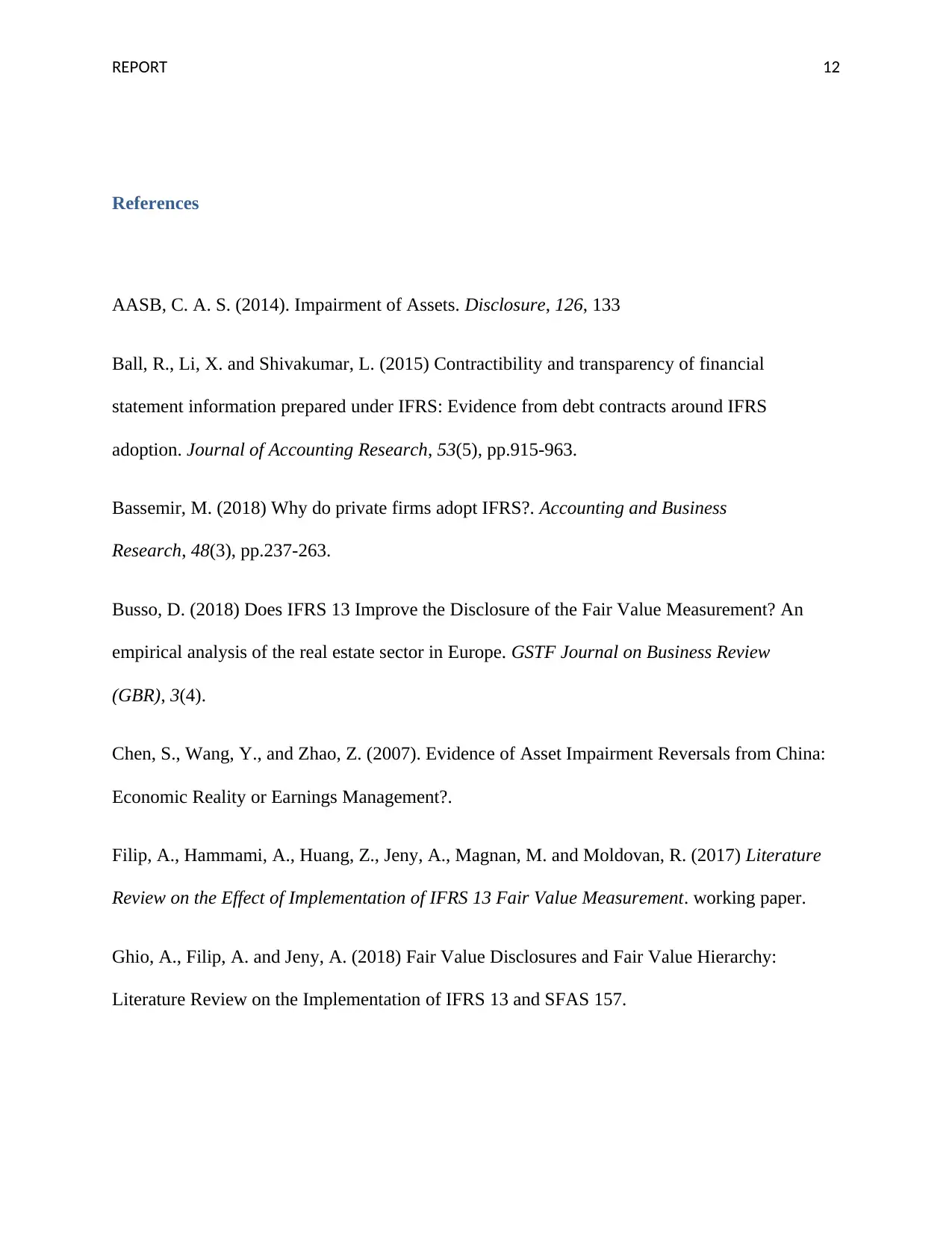
REPORT 12
References
AASB, C. A. S. (2014). Impairment of Assets. Disclosure, 126, 133
Ball, R., Li, X. and Shivakumar, L. (2015) Contractibility and transparency of financial
statement information prepared under IFRS: Evidence from debt contracts around IFRS
adoption. Journal of Accounting Research, 53(5), pp.915-963.
Bassemir, M. (2018) Why do private firms adopt IFRS?. Accounting and Business
Research, 48(3), pp.237-263.
Busso, D. (2018) Does IFRS 13 Improve the Disclosure of the Fair Value Measurement? An
empirical analysis of the real estate sector in Europe. GSTF Journal on Business Review
(GBR), 3(4).
Chen, S., Wang, Y., and Zhao, Z. (2007). Evidence of Asset Impairment Reversals from China:
Economic Reality or Earnings Management?.
Filip, A., Hammami, A., Huang, Z., Jeny, A., Magnan, M. and Moldovan, R. (2017) Literature
Review on the Effect of Implementation of IFRS 13 Fair Value Measurement. working paper.
Ghio, A., Filip, A. and Jeny, A. (2018) Fair Value Disclosures and Fair Value Hierarchy:
Literature Review on the Implementation of IFRS 13 and SFAS 157.
References
AASB, C. A. S. (2014). Impairment of Assets. Disclosure, 126, 133
Ball, R., Li, X. and Shivakumar, L. (2015) Contractibility and transparency of financial
statement information prepared under IFRS: Evidence from debt contracts around IFRS
adoption. Journal of Accounting Research, 53(5), pp.915-963.
Bassemir, M. (2018) Why do private firms adopt IFRS?. Accounting and Business
Research, 48(3), pp.237-263.
Busso, D. (2018) Does IFRS 13 Improve the Disclosure of the Fair Value Measurement? An
empirical analysis of the real estate sector in Europe. GSTF Journal on Business Review
(GBR), 3(4).
Chen, S., Wang, Y., and Zhao, Z. (2007). Evidence of Asset Impairment Reversals from China:
Economic Reality or Earnings Management?.
Filip, A., Hammami, A., Huang, Z., Jeny, A., Magnan, M. and Moldovan, R. (2017) Literature
Review on the Effect of Implementation of IFRS 13 Fair Value Measurement. working paper.
Ghio, A., Filip, A. and Jeny, A. (2018) Fair Value Disclosures and Fair Value Hierarchy:
Literature Review on the Implementation of IFRS 13 and SFAS 157.

REPORT 13
IFRS. (2017). IAS 36 Impairment of Assets. Available at:
<http://www.ifrs.org/issued-standards/list-of-standards/ias-36-impairment-of-assets/> Accessed
on 10-06-2019.
Kenyon, R. and Kenyon, C. (2016) Accounting for KVA under IFRS 13. Risk, March.
Lhaopadchan, S. (2010). Fair value accounting and intangible assets: Goodwill impairment and
managerial choice. Journal of Financial Regulation and Compliance, 18(2), 120-130.
Pandya, A. (2016) Resistance to IFRS 13-initial insights(Doctoral dissertation). New York:
Routledge
Reinstein, A., and Lander, G. H. (2014). Implementing the impairment of assets requirements of
SFAS No. 144: An empirical analysis. Managerial Auditing Journal, 19(3), 400-411.
Sundgren, S., Mäki, J. and Somoza-López, A. (2018) Analyst coverage, market liquidity and
disclosure quality: a study of fair-value disclosures by European real estate companies under IAS
40 and IFRS 13. The International Journal of Accounting, 53(1), pp.54-75.
Wingard, C., Bosman, J. and Amisi, B. (2016) The legitimacy of IFRS: An assessment of the
influences on the due process of standard-setting. Meditari Accountancy Research, 24(1),
pp.134-156.
IFRS. (2017). IAS 36 Impairment of Assets. Available at:
<http://www.ifrs.org/issued-standards/list-of-standards/ias-36-impairment-of-assets/> Accessed
on 10-06-2019.
Kenyon, R. and Kenyon, C. (2016) Accounting for KVA under IFRS 13. Risk, March.
Lhaopadchan, S. (2010). Fair value accounting and intangible assets: Goodwill impairment and
managerial choice. Journal of Financial Regulation and Compliance, 18(2), 120-130.
Pandya, A. (2016) Resistance to IFRS 13-initial insights(Doctoral dissertation). New York:
Routledge
Reinstein, A., and Lander, G. H. (2014). Implementing the impairment of assets requirements of
SFAS No. 144: An empirical analysis. Managerial Auditing Journal, 19(3), 400-411.
Sundgren, S., Mäki, J. and Somoza-López, A. (2018) Analyst coverage, market liquidity and
disclosure quality: a study of fair-value disclosures by European real estate companies under IAS
40 and IFRS 13. The International Journal of Accounting, 53(1), pp.54-75.
Wingard, C., Bosman, J. and Amisi, B. (2016) The legitimacy of IFRS: An assessment of the
influences on the due process of standard-setting. Meditari Accountancy Research, 24(1),
pp.134-156.
1 out of 13
Related Documents
Your All-in-One AI-Powered Toolkit for Academic Success.
+13062052269
info@desklib.com
Available 24*7 on WhatsApp / Email
![[object Object]](/_next/static/media/star-bottom.7253800d.svg)
Unlock your academic potential
© 2024 | Zucol Services PVT LTD | All rights reserved.





